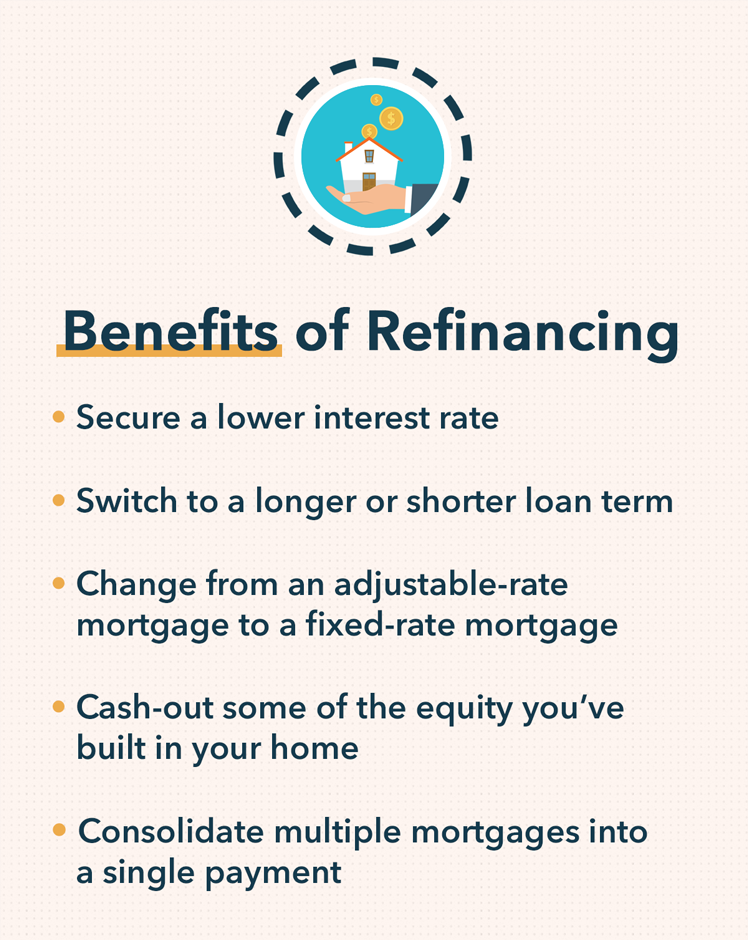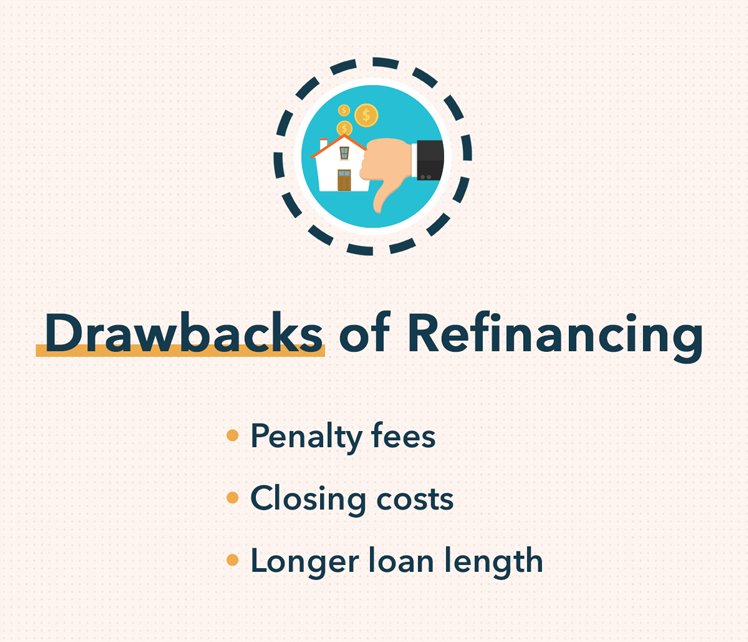What Does Refinancing Mean? Refinance Your Mortgage

If you’re like the majority of homeowners in the U.S., you make your mortgage payment monthly, with the idea that someday you’ll own your home outright. As you continue to pay off your total balance, your home equity rises and you become one step closer to owning your home.
The downside is, mortgages, like any other type of loan or line of credit, come with interest. That means you pay the total balance owed, plus the annual interest rate applied to your mortgage loan. Additionally, your lender also assigns specific payment schedules and other terms to your loan, some of which you might find favorable, others not so much. That’s where refinancing comes in.
What does refinancing mean? In the most basic sense, refinancing is a way to alter your mortgage terms by replacing your old mortgage with a new one that is better fit for your financial situation. A lower interest rate, more manageable payment schedule, a shorter loan term, or consolidating multiple mortgages are just a few of the ways refinancing your mortgage can be beneficial.
In this post, we’ll answer some important questions, such as, “what does refinancing mean?”, “when is refinancing a good idea?”, and “what are the pros and cons of refinancing?”. For fast answers on the subject of refinancing, use the links below to navigate ahead. Or, read end-to-end for a complete overview.
What is Refinancing?
Pros and Cons of Refinancing
Refinancing FAQs
What is Refinancing?
Refinancing, also known as “ a refi”, is a way for borrowers to restructure their mortgage, auto, personal, or other loan type for more favorable terms. During the mortgage refinance process, you might make one or several of the following adjustments to your mortgage:
Secure a lower interest rate
Switch to a longer or shorter loan term
Change from an adjustable-rate mortgage to a fixed-rate mortgage
Cash-out some of the equity you’ve built in your home
Consolidate multiple mortgages into a single payment
Sounds pretty good, right? It can be. Anytime you’re dealing with changes to a loan, it’s a good idea to read the fine print, take a close look at the pros and cons, and really understand what happens when you refinance.

What happens when you refinance?
When you refinance a loan, whether it be a mortgage, auto, or some other line of credit, you’ll need to start by paying off your original loan, which you can do with the help of your refinanced one, after you’ve been approved for a new loan, of course. Once you have settled up with your original lender, you’ll be left to pay off your new loan according to the payment terms outlined by your new lender.
Am I eligible for a refinance?
Think back to when you applied for your original mortgage — you likely filled out an application, they checked your credit score and lending history, assessed the property, and proposed a mortgage option for you based on your financial profile.
The process for refinancing is essentially the same. The new lender will consider your credit score, lending history, the value of your home, how much you want to borrow, and your income and assets before approving you for a new mortgage. Ideally, your finances would be in a shinier state than when you got your first mortgage, and you’ll likely be asking to borrow less money, therefore, a refinanced mortgage could offer you a more agreeable interest rate or loan terms.

When it comes to determining eligibility, it’s ultimately up to your lender to decide. According to Rocket Mortgage, homeowners looking to refinance should consider the following criteria before applying:
How long you’ve owned the house: Generally, you must have the title for a minimum of six months.
Your credit score: Your lender is ultimately the one who decides what they consider to be a “creditworthy” score, but there are some basic benchmarks you can use to help. A good credit score is considered 670 and higher on the FICO scale and 660 and higher on the VantageScore model.
Your current home equity: The general rule of thumb is that homeowners should have a minimum of 20 percent home equity in order to qualify for a refinance. 20 percent is also the minimum equity needed if you want to get rid of your mortgage insurance.
Other debts: In addition to assessing your credit score and other financial metrics, lenders will typically consider your other debt obligations before approving you for a new loan. Take a look at how you’re managing your current debts before applying for a refinanced mortgage.
Closing costs: When you close on a loan, you’re typically responsible for paying closing costs, including, appraisal fees, title fees, credit check fees, and more. Before applying for a refinance, take a look at your monthly budget to determine whether or not you can afford to pay the closing costs on a new loan. ProTip: Use our budgeting calculator to help!
Financial details: Part of the loan application process involves lenders taking a look at the greater picture of your finances, such as, your income and assets, homeowner’s insurance, title insurance, etc. Make sure you have this information handy to make the refinance process more efficient if you choose to proceed.
Types of mortgage refinancing
Now that you know the basic refinance definition, it’s time to dig a little deeper. It probably comes as no surprise to you, but it’s important to know that there’s no one-size-fits-all refinance. There are several different types of mortgage refinancing that depend on the outcome that you’re looking for.
Rate-and-term refinancing: This type of refinance only adjusts the rate and/or term length of the loan.
Cash-out refinancing: Allows borrowers to adjust the mortgage length and/or term, plus, it increases the amount of the loan. Cash-out refinances are generally used when homeowners want to borrow extra money to make home improvements or other big purchases.
Cash-in refinancing: This is basically the opposite of a cash-out refinance. With cash-in refinancing, you’d pay down more of the principal balance to decrease your loan amount, generally in exchange for a lower mortgage rate.

Note: Another reason some homeowners choose to refinance is to consolidate their debts; instead of making mortgage payments to separate lenders for multiple mortgages, you could refinance and lump all of your mortgages into a single loan.

Pros and Cons of Refinancing
Like any financial decision you’ll make in your lifetime, it’s a good idea to consider the pros and cons of your decision. With that said, let’s take a look at some of the benefits and risks associated with refinancing.
Pros
The advantages of refinancing are simple: making your mortgage terms work better for you. That could mean getting a lower interest rate, which would translate to interest savings, you could secure more manageable monthly payments which might work better for your budget, or you could adjust your loan terms to better suit your lifestyle and financial situation.

Cons
Penalty fees: Some mortgage lenders impose penalty fees if you pay off your mortgage before the term ends. These fees vary by lender, but could potentially add up to thousands of dollars.
Closing costs: As we mentioned, there are several closing costs associated with refinancing. Keep these costs in mind as you weigh your options.
Longer loan length: Should you choose to extend the length of your loan term in favor of lower monthly payments or some other benefit, you’ll be stuck paying off your mortgage longer, which could be problematic for certain homeowners.

Refinancing FAQs
So far, we’ve answered “what is refinancing?”, “what happens when you refinance?”, “what are the types of refinancing?”, and “what are the pros and cons of refinancing?”. If you still have some lingering questions, we’re here to help by answering these refinancing FAQs.
Does refinancing hurt your credit?
One of the costs of refinancing is that it may impact your credit temporarily. When you apply for a loan, your lender will check your credit score , conducting something that’s called a hard credit inquiry. Hard credit inquiries can drop your credit score by a few points, but it won’t impact your score forever.
Bottom line: Refinancing can hurt your credit score temporarily. However, if the savings and benefits are worth it, a quick dip in your score probably isn’t something to be too concerned about, especially if your credit is in good standing.
Is refinancing a good idea?
It depends. Everyone’s financial situation is different, so it’s important to take a close look at your current situation, assess whether you’re eligible for refinancing, and really understand what it means to refinance.
When is refinancing worth it?
Refinancing may be worth your while if you can qualify for a lower interest rate or secure better loan terms than you started with. Some financial experts say that refinancing can be a good idea if you can lower your interest rate by at least two percent.
How do I calculate the break-even period?
Something to consider when you’re refinancing your mortgage is how long it will take you to reap the benefits of your new loan after considering closing costs. Use the worksheet below to help you anticipate your break-even period.
Graphic
Recapping Refinancing
There are plenty of nuances to know about refinancing. As you consider whether it’s the right move for you, let’s recap some important points:
What does it mean to refinance?: Refinancing a loan is when you pay off your original loan and take out a new loan, ideally with more favorable loan terms like a lower interest rate or more manageable payment schedule.
When is it a good idea to refinance?: That depends on your unique financial situation. Refinancing can help you save money on interest and offer other important benefits, but it’s important to consider the benefits and risks in the context of your own finances.
To learn more about where your finances stand, check out the Mint app to set financial goals, glean insight into your financial health, and more.
The post What Does Refinancing Mean? Refinance Your Mortgage appeared first on MintLife Blog.
Original Source: blog.mint.com
Visited 741 Times, 1 Visit today
